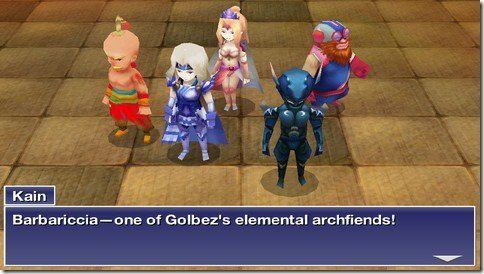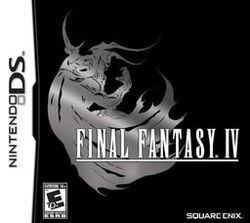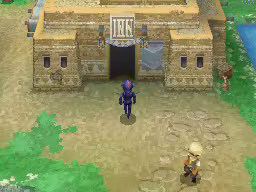Publisher(s) Square Enix Producer(s) Tomoya Asano Initial release date 20 December 2007 Genre Role-playing game | Director(s) Takashi Tokita Artist(s) Akira Oguro Series Final Fantasy | |
 | ||
Composer(s) Junya Nakano
Kenichiro Fukui Mode(s) Single-player, multiplayer Developers Square Enix Holdings, Matrix Software Platforms Nintendo DS, Android, iOS, Microsoft Windows Designers Nobuo Uematsu, Yoshitaka Amano, Takashi Tokita, Hiroyuki Ito Similar Final Fantasy games, Takashi Tokita games, Role-playing video games | ||
Final Fantasy IV (ファイナルファンタジーIV, Fainaru Fantajī Fō) is a Nintendo DS role-playing video game and an enhanced remake of the 1991 SNES game, Final Fantasy IV. It was released as part of the Final Fantasy series 20th anniversary celebrations on December 20, 2007 in Japan, on July 22, 2008 in North America, and on September 5, 2008 in Europe.
Contents

The game was developed by Matrix Software, the same team responsible for the 3D Final Fantasy III remake, and was supervised by members of the original development team: Takashi Tokita served as executive producer and director, Tomoya Asano as producer, and Hiroyuki Ito as battle designer. Animator Yoshinori Kanada wrote the new cutscenes.

The game was well received by critics and fans alike; it was praised for being sufficiently faithful to the original while expanding on many gameplay and story elements.
In 2012, the game was released for iOS on the App Store, for Android in 2013 and for Microsoft Windows in 2014.
Gameplay
Final Fantasy IV retains the original Active Time Battle System from the initial Super Nintendo release. Similar to the previous remake of Final Fantasy III on the Nintendo DS, the control of stylus is limited and optional in order to retain the same control input while allowing other players to use the Nintendo DS's unique touch control scheme. However, the remake features a new ability system known as the "Augment System", or the "Decant Ability System" (デカントアビリティシステム, Dekanto Abiriti Shisutemu) in the Japanese version. The system allows for certain character-only abilities to be transferred to other characters who did not have them in the original and previous re-releases of Final Fantasy IV. Up to three abilities can be transferred to temporary party members. When leaving the party, temporary characters will yield abilities of their own, the number of which is dependent on how many abilities they were given. There are also other abilities; some scattered around the world, and some that become available after certain story events. This new system entails another new feature: command menu customization. All commands in a character's battle menu, except the "Items" command, can be replaced with augments. This includes individual abilities that are ordinarily contained in a group (e.g. "Curaga" can be added directly to Rosa's command list, rather than only being accessible through the White Magic sub-list). The Augment System was devised to replace the system in Final Fantasy IV Advance where the characters that were temporary in the original version became playable again at a certain point, as the developers felt that this system changed the game too much.
Other exclusive enhancements to the DS version of the game include Minigames. Unlike the main game, minigames are stylus-control only. Their function is to increase the power of Rydia's personal Eidolon, Whyt (ポーチカ, Pōchika, Pochika in the Japanese version), who takes her place in the battle line-up, and acts under computer control according to abilities assigned to him by the player. The minigames can be played in either single-player or wireless (not online) multiplayer modes. The game also features a New Game Plus. This allows players to start a new game with certain enhancements, such as rare or secret items and equipment, carried over from a previously completed game. Certain other new features are only available in a New Game Plus, such as hidden bosses on the face of the moon and the summit of Mt. Ordeals. Because of the voice-acted scenes, Namingway cannot change any character's name as he did in the original game. After realizing this, he travels the world, changing his own name to fit each occupation he takes up. Examples of his name changes include "Mappingway" (charting the maps on the lower screen), "Campingway", and "Weddingway". Following Namingway around the world and engaging in his sidequest yields numerous rewards. With the removal of the limit on items that the player can carry, Fat Chocobo no longer stores items, and instead can be called on in order to access the new bestiary and the video and music player, as well as the Whyt minigames.
Plot
The original storyline of Final Fantasy IV is retained, and some of the previously missing script has been worked into the DS version in the form of flashbacks, including Golbez becoming Zemus's pawn and the childhoods of Cecil, Kain, and Rosa.
Development
The official developer blog (maintained by producer Tomoya Asano) has outlined several key features of the remake. As in the original, players can reform their party with whomever they choose as party leader. When the player enters the menu, the party leader will now appear on the bottom screen where the player can read their thoughts about what is happening in the story at that time (the development team suggests players check this feature often for humorous anecdotes).
Other developer blog entries have focused on the art and programming of the game. According to the art director, Matrix tried to make each location of the game feel unique. For example, the desert kingdom of Damcyan has taken on a Middle-Eastern flair, Fabul has been given a Chinese feeling, and Eblan has been given the feeling of a Ninja residence, which was not possible in the Super Famicom edition due to limited data capacity. The game displays more characters and enemies on screen during battle compared to Final Fantasy III, which required the modeling team to reduce the number of polygons per character. The main programmer also suggests that the game is much larger than Final Fantasy III from a data standpoint, and compressing all the data to fit on a 1Gb ROM was difficult, largely due to the voice data.
According to director Takashi Tokita, the scenario writer and lead game designer of the original release, three quarters of the original script had been left out of the original Super Famicom version. In a Q&A feature on the official Square Enix Members page, Tokita corrected this by saying that the original story script was never cut, but during the development of the original release, the game's text could not fit and had to be revised to a quarter of its intended size.
Music
In June 2007, Square Enix held a casting for a vocalist to sing a rendition of Final Fantasy IV's "Theme of Love" composed by Nobuo Uematsu. Megumi Ida was selected from approximately 800 applicants to perform the song "Tsuki no Akari" (月の明り, literally "moonlight") The song was arranged by Kenichiro Fukui, with the lyrics penned by scenario writer Takashi Tokita. It only appears in the Japanese release of the game, over the ending credits - international versions cut the song in its entirety and replace it with a music track from the game itself.
Reception
As of July 9, 2008, the game has sold 612,044 copies in Japan. Worldwide it has sold 1.1 million copies.
Final Fantasy IV was well received by critics. It was a nominee for Best RPG on the Nintendo DS in IGN's 2008 video game awards.
